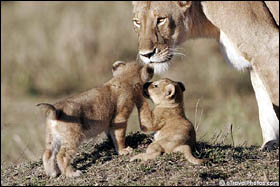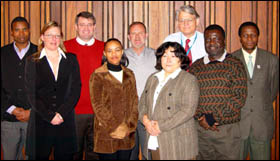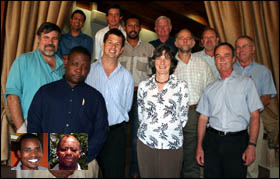SAEON's governing structures can look back on a job well done
|
At the end of 2006, the term of office of the members of the SAEON
Advisory Board and Technical Steering Committee (TSC) came to an end.
These two governance bodies have played a crucial role in the first
three years of SAEON's existence by laying solid foundations and
providing direction.
"The SAEON National Office was fortunate to have been the recipient of sound advice whilst pioneering the development of the Network," says SAEON Head Johan Pauw. "The Advisory Board and TSC were instrumental in steering SAEON successfully on its course."
Highlights of the past three years
The TSC held rather intense workshops and produced founding documents such as the 'Design of SAEON', which informed the development process of the Network and guided the implementation of the SAEON nodes. Steering Committee members also served on Task Teams mandated to advise the National Office on the hosting arrangements of the different nodes.
Reflecting on the highlights of the past three years, Dr Bob Scholes of the Council for Scientific and Industrial Research (CSIR) and a member of the TSC said that the very fact of South Africa now having an environmental observation network where we haven't had anything like that before is probably the leading highlight. Other highlights include the design of the network, interrogating the key attributes and getting the nodes started.
He sees SAEON's focus on collecting and analysing information and making it available rather than collecting new information as an important principle. "The idea of not simply adopting a Long-Term Environmental Research (LTER) model, or any other model that was out there, but designing the network specifically for South African circumstances was another important factor," he says. "The actual implementation has been a rewarding experience - seeing SAEON starting to come on stream, establishing one pilot node and then rapidly expanding across the landscape."
He also mentions that the broad community has largely bought into SAEON, despite the fact that issues such as whether this was a good way of spending resources, the location of the network and the principle of data sharing could have met with some resistance.
As for SAEON's role in Southern Africa, he feels that SAEON played a nurturing role for the Environmental Long-Term Observatories of southern Africa (ELTOSA). Although SAEON will never be able to invest substantial financial resources in ELTOSA, it has set up a website and supported the annual ELTOSA conference, drafted and submitted papers and funding proposals, leading by example and providing technical assistance wherever possible (see reference list below).
"It makes a lot of sense to do long-term environmental observations on a regional rather than a national basis for a variety of reasons," he says, and explains that just because a particular ecosystem extends across the South African border doesn't mean that this is necessarily the best place to observe that system.
Marjorie Pyoos, Group Executive of the Department of Science and Technology and SAEON Advisory Board member, singles out two specific highlights from her perspective as a Board member:
"Firstly, the considerable learning during the process for establishing an appropriate methodology by which we would select SAEON sites was quite significant," she says, "and it was a lengthy and highly frustrating process due to the wide range of stakeholders that had to be consulted."
Marjorie was extensively involved in assessing the methodology, dealing with the responses from the technical team and the SAEON staff themselves, whose commitment, she says, was quite impressive. All the non-governmental members of the technical teams were giving freely of their time. It was a steep learning curve for everyone involved. "This learning, in setting up the South African Environmental Observation Network, is one that the technical team and management of SAEON have to share with our partners elsewhere in Africa, and possibly elsewhere in developing countries," she says.
The launch of the Ndlovu Node, the first SAEON Node, and the strong buy-in that SAEON achieved across so many research sectors within South Africa constitute another definite highlight. "It was extremely pleasing to see the buy-in from SANParks, science councils such as the Agricultural Research Council (ARC), the CSIR, University of the Witwatersrand and government departments such as the Department of Agriculture," she says. Climate science and climate change science requires a multidisciplinary effort and the opportunity to integrate the research outputs of these institutions is certainly demonstrated through the work of the SAEON nodes.
The members of both governing structures are also pleased with all the organizations now becoming more closely involved with SAEON by signing accession agreements.
Future perspective
According to Dr Scholes, SAEON now needs to become firmly established; it needs to get beyond its start-up phase into the operational phase. And this is certainly possible within the next three years. Although the new nodes will still be in the set-up phase, the established nodes ought to become highly operational in this period. "They should be generating products, they should be established places for people to go and do work, there should be a free flow of information, they should be well-accepted as an essential part of the scientific landscape by all facets of the community - the user community, the provider community and the research community," Dr Scholes explains.
According to Dr Albert van Jaarsveld, past Chairman of the SAEON Advisory Board, the Board ensured that SAEON was placed on a sustainable funding basis during the establishment phase, with the future prospect of a solid funding basis of R15 million a year from the Department of Science and Technology.
Evolutionary development
At its last meeting, the Technical Steering Committee converged on the notion that SAEON requires more focused small group meetings rather than all-inclusive large meetings, as the Network's development has progressed to the stage where detailed discussions among specialists will be more productive than higher-order discussions by a broadly representative group.
"Evolutionary development is taking place within SAEON, but the need for high-level coordinating meetings of the Advisory Board and the Technical Steering Committee will remain, although less frequent," Johan Pauw explains. The process to appoint new members to the SAEON Technical Steering Committee and Advisory Board is ongoing and the first meetings of the year will take place during May to June.
"Deliberations by the advisory structures were documented in detail to enable future reference to the rationale for certain directions embarked on by SAEON," he concludes.
The SAEON Advisory Board advises the National Office, the Technical Steering Committee and the National Research Foundation (NRF) at policy level. The specific terms of reference for the Advisory Board are to:
- provide strategic direction consistent with national priorities;
- develop policy frameworks consistent with stakeholder expectations;
- facilitate high-level networking and communication;
- evaluate progress; and
- advise the NRF President and CEO.
The Advisory Board performs an annual review of the National Office. The review focuses on the annual report, minutes of meetings of both the Advisory Board and the Technical Steering Committee, and the goals set out in the annual Business Plan.
The Technical Steering Committee (TSC) advises the National Office and the NRF at scientific and operational levels. The specific terms of reference for the Advisory Board are to:
- develop the overall research framework and observation programme;
- advise on criteria and procedure for node development;
- advise on education outreach and communication strategies, including national reporting;
- advise on IT requirements and data management policies;
- foster national and international collaborations;
- develop the science programme of the biennial SAEON Summit;
- advise on policy with regard to the role of research performed and funded by individual SAEON partners; and
- appoint and task committees that are not necessarily composed of TSC members. The TSC performs a three-year scientific and organizational review of the nodes.
REFERENCE LIST
- Henschel, J & Pauw, J.C., 2002. Environmental Observatories: LTER á la Africa. In: Rebirth of Science in Africa. Baijnath, H., & Singh, (eds). Umdaus Press, Johannesburg.
- Henschel, J., Pauw, J., Banyikwa, F., Brito, R., Chabwela, H., Palmer, T., Ringrose, S., Santos, L., Sitoe, A. and Van Jaarsveld, A., 2003. Developing the Environmental Long-Term Observatories Network of Southern Africa (ELTOSA). South African Journal of Science 99 (March/April): 100-108.
- Pauw, J.C., Henschel J.R., Sitoe, A.A., Chimphamba, J.B., Kanyanga, J.K. & Ringrose, S. 2007. Ecological Networking in Southern Africa: The ELTOSA Experience. International Seminar on Information Circulation Systems in scientific and practical approaches to combat desertification. Published in: http://nrd.uniss.it/sections/aid-ccd/docu_rep4.htm
Related content













